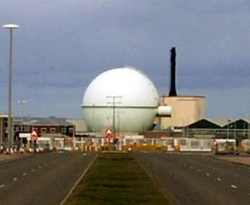A team of underwater robots could scour the offshore next to the Dounreay nuclear site to remove radioactive particles from the seabed and reduce the number being washed onto the beach if proposals by the UK Atomic Energy Authority (UKAEA) are approved.
 Radioactive particles escaped into the environment, mainly during the period of reprocessing during the early years of the Dounreay site. The systems in place to minimise particulate release, including a diffuser, were not sufficiently effective to prevent the release of particles. Although the particles are not thought to represent an threat to the environment the UKAEA has carried out a two-year consultation to determine what action to take.
Radioactive particles escaped into the environment, mainly during the period of reprocessing during the early years of the Dounreay site. The systems in place to minimise particulate release, including a diffuser, were not sufficiently effective to prevent the release of particles. Although the particles are not thought to represent an threat to the environment the UKAEA has carried out a two-year consultation to determine what action to take.
In is proposed that over the next seven years remotely operated vehicles will scour around 600,000 square metres of seabed, an area approximately equivalent to sixty football pitches, monitoring and recovering particles. During the fourth year the process would be integrated with the remediation of the diffuser.
The cost of carrying out this clean-up is currently esitmated at 18-25 million pounds, although this figure will be more precisely estimated after trials of the remote recovery equipment later this year.
Simon Middlemas, Dounreay Director said: "We have done an enormous amount of technical studies and have accumulated a huge amount of information which allows us to move forward to identify options which clearly, after extensive consultation, shows that this is an environmentally and publicly acceptable way forward."
Duncan McLaren, chief executive of Friends of the Earth Scotland, said: "We welcome the fact that a proper clean-up could be under way very soon."
A cleaner beach could make the Dounreay site more attractive for future visitors to the famous golfball-shaped Dounreay Fast Reactor. A study by the UKAEA into future uses of the site proposed that the reactor building could be converted to a hotel, already dubbed "Fallouty Towers" in some Scottish newspapers.
Other suggested uses for the site include a nightclub, a conference centre, a space observatory, a leisure centre or a nuclear museum, although demolition of the site remains a strong possibility. Futher consideration will be given to the future of the site following an examination by industrial archaeologists in the spring of 2008.
Further information
UKAEA
WNA's Radioactive Wastes information paper





_18570.jpg)
_16159.jpg)
_49205.jpg)





